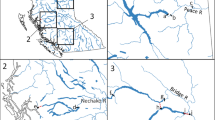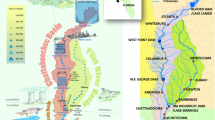Abstract
The US Army Corps of Engineers, the US Bureau of Reclamation, and the Bonneville Power Administration initiated the Columbia River System Operation Review (SOR) in 1990. The SOR will assist agencies in comparing the benefits and risks to Columbia River uses and natural resources from alternative strategies for using Columbia River water. Focusing on 14 federal dams within the basin, the agencies are attempting to improve on the efficient and coordinated use of the Columbia River system. An initial screening of all potential strategies of reservoir operation was necessary to reduce the number of possibilities to a limited set for detailed analysis. To that end, the Resident Fish Work Group of the SOR developed spreadsheet models capable of assessing the impacts of different management strategies on resident fish at six storage reservoirs. The models include biological, physical, and hydrological relationships important to resident fish specific to each reservoir. Alternatives that kept the reservoirs near full pool and held stable during the growing season resulted in positive benefits to resident fish at all locations modeled. Conversely, alternatives designed to improve anadromous fish survival with increased instream flow generally had a negative impact on the resident fish in the reservoirs modeled. The models developed for resident fish in the screening analysis phase of the SOR were useful in assessing the relative impact to resident fish from a large number of alternatives. The screening analysis demonstrated that future analytical efforts must consider trade-offs among river uses/resource groups, among reservoirs throughout the basin, and among resident fish species within a reservoir.
Similar content being viewed by others
Literature Cited
Beckman, L. G., J. F. Novotny, W. R. Parson, and T. T. Tarrell. 1985. Assessment of the fisheries and limnology in Lake F.D. Roosevelt 1980–1983. US Fish and Wildlife Service. Final report to the U.S. Bureau of Reclamation.
Bonneville Power Administration, US Army Corps of Engineers, and US Bureau of Reclamation. 1991. The Columbia River system: the inside story. System Operation Review Interagency Team, Portland, Oregon.
Bonneville Power Administration, US Army Corps of Engineers, and US Bureau of Reclamation. 1992. Screening analysis, vol 2, impact results. System Operation Review Interagency Team, Portland, Oregon.
Bonneville Power Administration, US Army Corps of Engineers, and US Bureau of Reclamation. 1994. Columbia River System Operation Review, draft environmental impact statement: Appendix k, resident fish. System Operation Review, Interagency Team, Portland, Oregon.
Fraley, J., B. Marotz, B. Decker-Hess, W. Beattie, and R. Zubik. 1989. Mitigation, compensation, and future protection for fish populations affected by hydropower development in the upper Columbia River system, Montant, USA.Regulated Rivers: Research and Management 3:3–18.
Maiolie, M., D. P. Statler, and S. Elam. 1993. Dworshak Dam impact assessment and fishery investigation and trout, bass, and forage species. Idaho Department of Fish and Game, and Nez Perce Department of Fisheries Management. Combined annual report to the Bonneville Power Administration, Portland, Oregon.
May, B., and J. Fraley. 1986. Quantification of Hungry Horse Reservoir water levels needed to maintain or enhance reservoir fisheries. Montana Department of Fish, Wildlife, and Parks. Annual report to Bonneville Power Administration, Portland, Oregon.
May, B., and S. L. McMullin. 1984. Quantification of Hungry Horse Reservoir water levels needed to maintain or enhance reservoir fisheries. Montana Department of Fish, Wildlife, and Parks. Annual report to Bonneville Power Administration, Portland, Oregon.
May, B., and T. Weaver. 1987. Quantification of Hungry Horse Reservoir water levels needed to maintain or enhance reservoir fisheries. Montana Department of Fish, Wildlife, and Parks. Annual report to Bonneville Power Administration, Portland, Oregon.
May, B., and R. J. Zubik. 1985. Quantification of Hungry Horse Reservoir water levels needed to maintain or enhance reservoir fisheries. Montana Department of Fish, Wildlife, and Parks. Annual report to Bonneville Power Administration, Portland, Oregon.
May, B., S. Glutting, T. Weaver, G. Michael, B. Morgan, P. Suek, J. Wachsmuth, and C. Weichler. 1988. Quantification of Hungry Horse Reservoir water levels needed to maintain or enchance reservoir fisheries: methods and data summary, 1983–1987. Montana Department of Fish, Wildlife, and Parks. Annual Report to Bonneville Power Administration, Portland, Oregon.
Northwest Power Planning Council. 1994. Columbia River Basin Fish and Wildlife Program. Document 94–55. Portland, Oregon.
Paragamian, V. L., and E. C. Bowles. 1995. Factors affecting survival of kokanees stocked in Lake Pend Oreille, Idaho.North American Journal of Fisheries Management 15:208–219.
Shiklomanov, I. A. 1993. World freshwater resources. Pages 13–24in P. H. Gleik (ed.), Water in crisis, a guide to the world's freshwater resources. Oxford University Press, New York.
Author information
Authors and Affiliations
Additional information
Pacific Northwest Laboratory is operated by Battelle Memorial Institute for the US Department of Energy under contract DE-AC06-76RLO 1830.
Rights and permissions
About this article
Cite this article
Geist, D.R., Vail, L.W. & Epstein, D.J. Analysis of potential impacts to resident fish from Columbia River System Operation alternatives. Environmental Management 20, 275–288 (1996). https://doi.org/10.1007/BF01204012
Issue Date:
DOI: https://doi.org/10.1007/BF01204012




